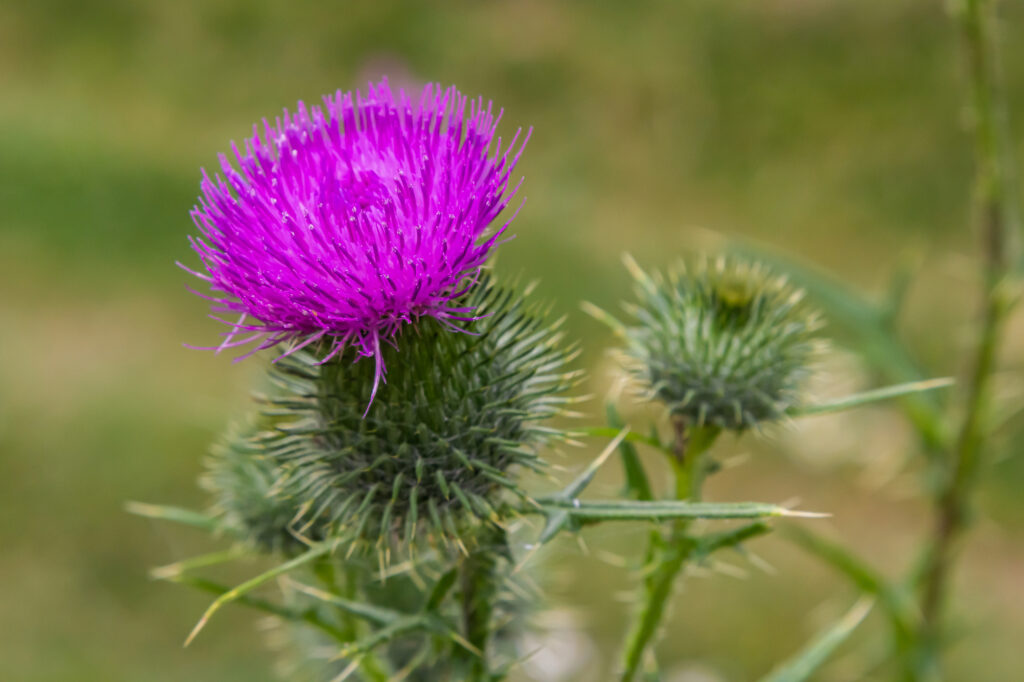Blessed thistle (Cnicus benedictus) is a thorny, flowering plant native to the Mediterranean region. For centuries, extracts or teas of blessed thistle have been used to treat indigestion, infections, and wounds. While research on the plant’s medicinal properties is spotty, some evidence suggests that the tannins present in blessed thistle might help with diarrhea, cough, or swelling.
Researchers at the University of Cologne in Germany, however, chose to focus on another compound isolated from blessed thistle—cnicin. Specifically, they were interested in testing whether it could help speed regeneration of injured nerve fibers known as axons. The results of their study were published in the July 2024 issue of the journal Phytomedicine.
While axons have the ability to completely regenerate, their slow growth rate often hinders full recovery. This has made efforts to speed regeneration a prime focus of research. Previous research found that parthenolide, a compound isolated from the herb feverfew, showed promise in speeding axon regrowth. The problem is that parthenolide’s poor oral bioavailability limits its use as a treatment.
With that in mind, the German team set out to determine whether cnicin, a similar but more bioavailable compound, might prove to be a better alternative. First, they tested cnicin’s effectiveness in animal models of nerve damage. A group of male and female adult mice, Lewis rats, and male New Zealand rabbits were anesthetized, and operations were performed to crush their sciatic nerves. After the surgery, the animals received daily intravenous or oral doses of cnicin or parthenolide.
A series of tests were performed over the next 28 to 63 days to determine how quickly the animals were recovering from their injuries. Results showed that the cnicin sped recovery just as well as parthenolide. What’s more, blood tests showed that cnicin has a bioavailability of 84.7%, making it viable as an oral treatment.
Because treatments in a clinical setting can often be delayed, the researchers isolated four groups of animals and placed them on delayed treatment schedules. While results ultimately showed that immediate and continuous cnicin treatment produced better results, the delayed treatment was still effective.
The researchers tested cnicin in vitro on human cells. Primary cultures were prepared using retinae isolated from the human eyes of two adult patients. The retinae were dissected from the eyecups, and the vitreous body was removed. Afterward, the retinae were cut into 8 pieces and processed in individual cultures. The cultures were then incubated with either cnicin or parthenolide. After four days, the cultures were analyzed to examine nerve regrowth. And again, cnicin proved just as effective as parthenolide in promoting nerve regrowth.
Conclusions
“The current study underscores the potential of cnicin as a readily administered oral compound for augmenting axonal regeneration,” the researchers wrote in their conclusion. “It demonstrates a substantial in vivo and in vitro impact across multiple species, including an effect on cultured primary human neurons, even at remarkably low dosages. Consequently, cnicin is a promising candidate for further drug development to treat nerve damage and promote regeneration.”
The researchers’ next step is human clinical trials, especially to determine effective dosages. “The correct dose is very important here, as Cnicin only works within a specific therapeutic window,” said Professor Dietmar Fischer, one of the study’s leaders. “Doses that are too low or too high are ineffective. This is why further clinical studies on humans are crucial.”






